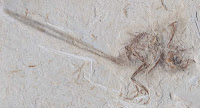The earliest Bird known in the fossil record is Archaeopteryx lithographica from the Late Jurassic Solnhofen Limestone of Germany, after which no further Birds are known until the Early Cretaceous Jehol Biota of northeastern China (and possibly North Korea), where numerous Bird specimens have been found, including members of the Enantiornithes (the most abundent group of Birds in the Cretaceous fossil record) and Ornithuromorpha (the group that includes all modern Birds), as well as distinctive groups such as the Jeholornithiformes, Sapeornithiformes and Confuciusornithiformes not known from as other deposits.
In a paper published in the journal Scientific Reports on 25 January 2016, Min Wang of the Key Laboratory of Vertebrate Evolution and Human Origins at the Institute of Vertebrate Paleontology and Paleoanthropology of the Chinese Academy of Sciences and the State Key Laboratory of Palaeobiology and Stratigraphy at the Nanjing Institute of Geology and Palaeontology, Xiaoli Wang and Yan Wang of the Institute of Geology and Paleontology at Linyi University and the Shandong Tianyu Museum of Nature and Zhonghe Zhou, again of the Key Laboratory of Vertebrate Evolution and Human Origins, describe a new species of early Bird from the Jiufotang Formation of Liaoning Province, one of the deposits considered to make up the Jehol Biota.
The new species is named Chongmingia zhengi, where Chongmingia refers to Chongming, a mythical Bird from ancient China, and zhengi honours Xiaoting Zheng for his contributions to the founding of the Shandong Tianyu Museum of Nature. The species is described from a single partial skeleton, with some associated soft tissue and feathers, but lacking the head and tail.
Photograph and line drawing of Chongmingia zhengi. Abbreviations: ad-1, proximal phalanx of the alular digit; am, alular metacarpal; ca, caudal vertebra; cm, carpometacarpus; cv, cervical vertebra; fe, femur; fu, furcula; ga, gastralia; gs, gastroliths; hu, humerus; md-1, 2, phalanx 1, 2 of the major digit; mtI, metatarsal I; mtV, metatarsal V; pd, pedal digit; pu, pubis; ra, radius; rad, radiale; sc, scapulocoracoid; sy, synsacrum; ti, tibiotarsus; tm, tarsometatarsus; ul, ulna; uln, ulnare; l/r, left or right side. Scale bars are 50 mm. Min Wang in Wang et al. (2016).
Chongmingia zhengi shows a number of unique features not seen in any other early Bird including a robust fercula (wishbone) with an unusually sharp angle and a coracoid and scapula fused together into a single bone, the scapulocoracoid. A scapulacoracoid is also found in a wide range of non-Avian Dinosaurs, including groups closely related to Birds, such as Dromeosaurs and Oviraptors, as well as in some Amphibians, Pterosaurs and modern Ratite Birds (Ostriches, Emus etc.). The presence of a scapulacoracoid in flightless Birds and close Bird relatives might suggest that it is not a good adaptation for flight, however Pterosaurs are thought to have been powerful fliers, and the structure of the scapulacoracoid in Chongmingia zhengi is quite different to that seen in Ratites, with the bones fused at approximately right angles tather than roughly parallel, suggesting that Chongmingia zhengi rather than being a weak flier, may have achieved flight with a unique set of adaptations.
See also...
 Preserved feathers in an Enantiornithine Bird from the Early Cretaceous Crato Formation of Brazil. While feathers have been known in
fossil Birds...
Preserved feathers in an Enantiornithine Bird from the Early Cretaceous Crato Formation of Brazil. While feathers have been known in
fossil Birds...
 Preserved stomach contents in Early Cretaceous Ornithuromorph Birds. The Early Cretaceous Jehol Group of China has produced a remarkable
number of well-preserved fossils of Mesozoic Birds, adding greatly to our
understanding of the early history of this group...
Preserved stomach contents in Early Cretaceous Ornithuromorph Birds. The Early Cretaceous Jehol Group of China has produced a remarkable
number of well-preserved fossils of Mesozoic Birds, adding greatly to our
understanding of the early history of this group...
 Two new species on Enantiornithine Birds from the Jehol Biota. The deposits of the Jehol Group in northeastern China have yielded a
spectacular number of fossil Birds and closely related non-Avian
Theropod Dinosaurs over...
Two new species on Enantiornithine Birds from the Jehol Biota. The deposits of the Jehol Group in northeastern China have yielded a
spectacular number of fossil Birds and closely related non-Avian
Theropod Dinosaurs over...
Follow Sciency Thoughts on Facebook.
See also...
 Preserved feathers in an Enantiornithine Bird from the Early Cretaceous Crato Formation of Brazil. While feathers have been known in
fossil Birds...
Preserved feathers in an Enantiornithine Bird from the Early Cretaceous Crato Formation of Brazil. While feathers have been known in
fossil Birds...  Preserved stomach contents in Early Cretaceous Ornithuromorph Birds. The Early Cretaceous Jehol Group of China has produced a remarkable
number of well-preserved fossils of Mesozoic Birds, adding greatly to our
understanding of the early history of this group...
Preserved stomach contents in Early Cretaceous Ornithuromorph Birds. The Early Cretaceous Jehol Group of China has produced a remarkable
number of well-preserved fossils of Mesozoic Birds, adding greatly to our
understanding of the early history of this group... Two new species on Enantiornithine Birds from the Jehol Biota. The deposits of the Jehol Group in northeastern China have yielded a
spectacular number of fossil Birds and closely related non-Avian
Theropod Dinosaurs over...
Two new species on Enantiornithine Birds from the Jehol Biota. The deposits of the Jehol Group in northeastern China have yielded a
spectacular number of fossil Birds and closely related non-Avian
Theropod Dinosaurs over...
